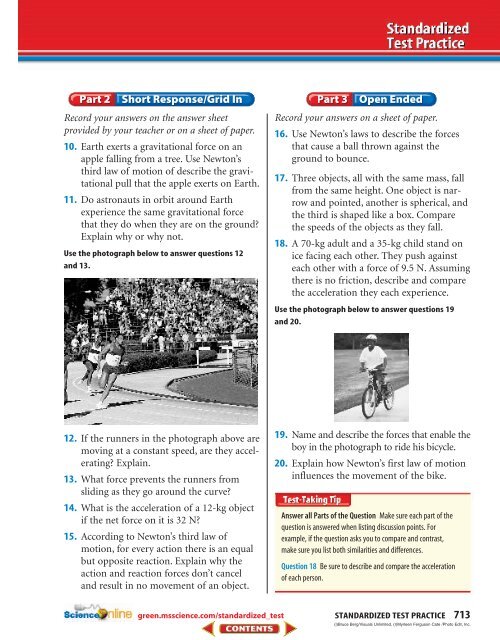Chapter 23: Newton's Laws of Motion
Chapter 23: Newton's Laws of Motion
Chapter 23: Newton's Laws of Motion
You also want an ePaper? Increase the reach of your titles
YUMPU automatically turns print PDFs into web optimized ePapers that Google loves.
Record your answers on the answer sheet<br />
provided by your teacher or on a sheet <strong>of</strong> paper.<br />
10. Earth exerts a gravitational force on an<br />
apple falling from a tree. Use Newton’s<br />
third law <strong>of</strong> motion <strong>of</strong> describe the gravitational<br />
pull that the apple exerts on Earth.<br />
11. Do astronauts in orbit around Earth<br />
experience the same gravitational force<br />
that they do when they are on the ground?<br />
Explain why or why not.<br />
Use the photograph below to answer questions 12<br />
and 13.<br />
12. If the runners in the photograph above are<br />
moving at a constant speed, are they accelerating?<br />
Explain.<br />
13. What force prevents the runners from<br />
sliding as they go around the curve?<br />
14. What is the acceleration <strong>of</strong> a 12-kg object<br />
if the net force on it is 32 N?<br />
15. According to Newton’s third law <strong>of</strong><br />
motion, for every action there is an equal<br />
but opposite reaction. Explain why the<br />
action and reaction forces don’t cancel<br />
and result in no movement <strong>of</strong> an object.<br />
green.msscience.com/standardized_test<br />
Record your answers on a sheet <strong>of</strong> paper.<br />
16. Use Newton’s laws to describe the forces<br />
that cause a ball thrown against the<br />
ground to bounce.<br />
17. Three objects, all with the same mass, fall<br />
from the same height. One object is narrow<br />
and pointed, another is spherical, and<br />
the third is shaped like a box. Compare<br />
the speeds <strong>of</strong> the objects as they fall.<br />
18. A 70-kg adult and a 35-kg child stand on<br />
ice facing each other. They push against<br />
each other with a force <strong>of</strong> 9.5 N. Assuming<br />
there is no friction, describe and compare<br />
the acceleration they each experience.<br />
Use the photograph below to answer questions 19<br />
and 20.<br />
19. Name and describe the forces that enable the<br />
boy in the photograph to ride his bicycle.<br />
20. Explain how Newton’s first law <strong>of</strong> motion<br />
influences the movement <strong>of</strong> the bike.<br />
Answer all Parts <strong>of</strong> the Question Make sure each part <strong>of</strong> the<br />
question is answered when listing discussion points. For<br />
example, if the question asks you to compare and contrast,<br />
make sure you list both similarities and differences.<br />
Question 18 Be sure to describe and compare the acceleration<br />
<strong>of</strong> each person.<br />
STANDARDIZED TEST PRACTICE 713<br />
(l)Bruce Berg/Visuals Unlimited, (r)Myrleen Ferguson Cate /Photo Edit, Inc.

















